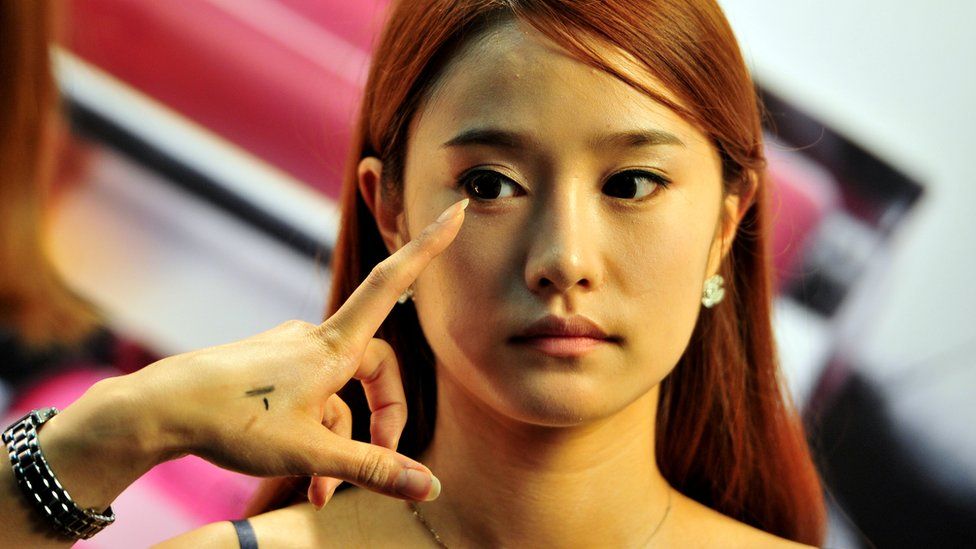The key ingredients of South Korea's skincare success
- Published

If you have never used a Korean face cream made from snail slime, then you may be missing out.
Likewise you may be being left behind if you don't spend an hour or two each week wearing a Korean face mask made from seaweed.
These are two products at the forefront of the latest big trend to hit the global skin care and cosmetics industry - the boom in such items developed and made in South Korea.
The Asian country has long been obsessed with skincare - South Korean women spend twice as much of their income on beauty products and make-up than their American counterparts. Meanwhile, South Korean men spend more on skincare than those in any other country.
Such a dedication to looking and feeling good means that South Korea is at the forefront of research into new skincare products, and its exports of such items are soaring.
Last year, South Korea exported more than $2.64bn (£1.85bn) of cosmetics goods, a new high, according to the Korea Customs Service. This compares with $1bn in 2012, and $1.91bn in 2014.
One of the biggest export markets for Korean skincare products, which have been collectively dubbed "K-beauty", is the US, where the big rise in sales has been led by small firms, more often set up by young Americans of Korean ancestry.
And the ingredients aren't ones traditionally found in American or European products. Snail extract, for example, is supposed to stimulate the formation of collagen and elastin, is used in moisturisers and spot treatments.
Dual knowledge
In a beauty salon in New York's Koreatown district, business partners Christine Chang, 34, and Sarah Lee, 35, are holding forth on the newest trends in skincare products from South Korea.
Ms Lee holds up a poster of a frilly, white, translucent mushroom, explaining that the fungus is a new "ultra-hydrating" ingredient being used in skincare.
She has the full attention of her audience, a select group of beauty editors diligently taking notes.
Both Korean Americans, Ms Lee and Ms Chang first met 10 years ago, whilst working for global skincare giant L'Oreal in South Korea.
Back in 2014 they decided to use their dual knowledge of Korean skincare products and the US to start their own company called Glow Recipe.
Their business imports such items from South Korea, and its website sells 150 products. Their bestseller is a face mask made from kelp covered in a hydrating serum, which retails for $14.
Ms Lee and Ms Chang says the business has been growing at an average 70% ever quarter since they launched.
'Cult following'
The popularity of Korean beauty products in the US can be traced back to 2011 when, the then unknown product, "BB cream" first launched in the country.
BB cream is a hybrid moisturiser and foundation that Korean women had been using for years. In 2014 the US market for BB cream alone was worth $164m.
"South Korea's beauty industry has seen phenomenal growth," says Sarah Jindal, analyst for market research firm Mintel.
Still, there are some major differences between the Korean and the western approach to beauty. For example, while in the west it is typical for women to follow a three-step facial regime of cleanse-tone-moisturise, in South Korea there are 10 different steps, including the use of "essence" and "ampoule" creams, and a "sheet mask".
Bridging this beauty gap is where people like Korean American Charlotte Cho come in. Ms Cho runs the online beauty blog and shop Soko Glam with her husband, and also recently launched a book about Korean beauty secrets.
A native of California who moved to New York, Ms Cho, 30, says: "We helped drive this growth in 2012 [of the sale of Korean beauty products], when we started the company.
"At the time, I felt like there was a huge gap between US and Korea. There was a cult following, but no proper bridge between the two."
The blog and the book help explain and spread the Korean "beauty philosophy", and Ms Cho is a proponent of the 10-step routine. She says SoKo Glam is growing "exponentially" in its third year.
'Cherry pick'
Megan McIntyre, beauty director at lifestyle website refinery29.com, says that most American women who try the 10 steps can't keep it up.
"After a while, many women who tried to keep up realised that it was pretty damn expensive to use ten plus products a day, and there wasn't necessarily a huge, noticeable difference in their skin," she says.
"So instead they cherry picked the products that were best for their skin. An essence here, an ampoule there, an under-eye mask for emergencies.
"It became less about emulating the entire routine and more about finding something new to boost an existing routine."
But the dilemma for Western consumers remains - where to begin with this plethora of products?
Alicia Yoon, who runs New York-based Peach and Lily, an online store selling imported Korean beauty products, says it is important that firms like hers don't sell too many items.
"Our curation process is so rigorous that only 5% of the products we look at really make our cut," she explains.
From thousands of South Korean brands, she picked out about 50, and then visited their companies to look closely at their research and development process.
Ms Yoon, 33, who quit her job in private equity to start her company in 2012 says she hasn't looked back since.